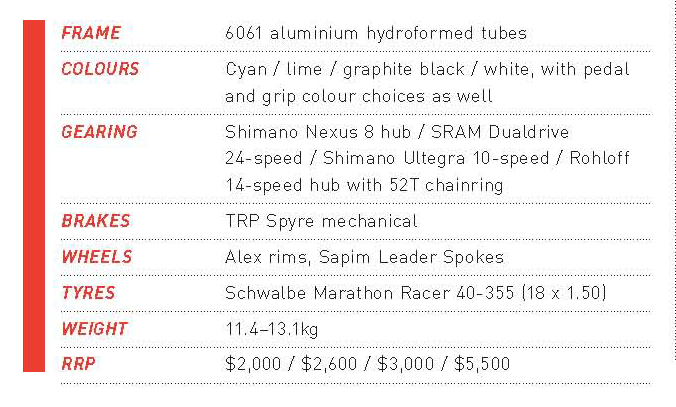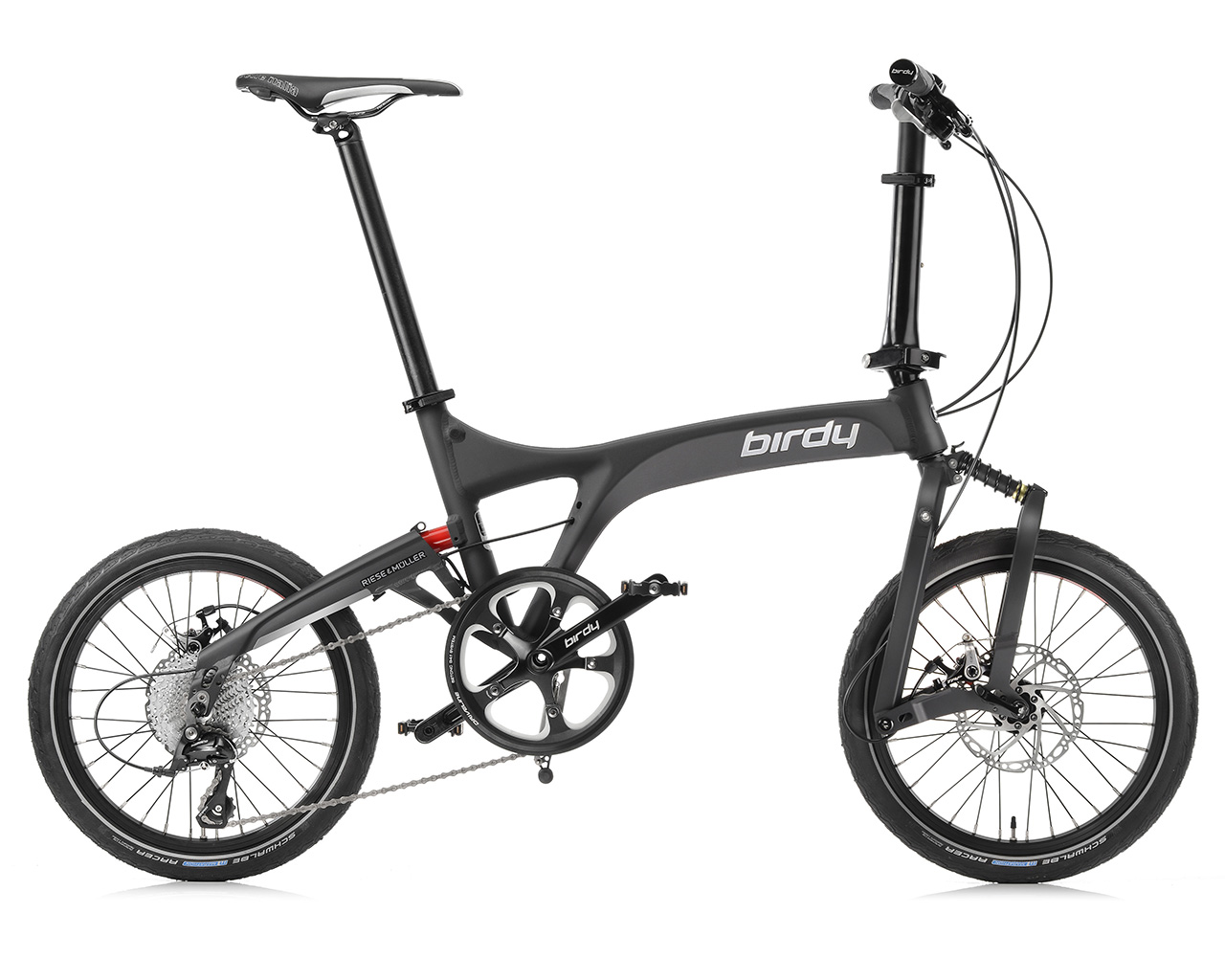Now with disc brakes across four configurations, and other key refinements, the Birdy range has a new lease of life. Simon Vincett test rode and reviews.
Since it was launched in 1995, the Birdy by Riese & Muller was immediately recognised as a significant alternative in the category of folding bikes. If the Brompton is the iPhone of folding bikes – iconic, great to use but locked into its own proprietary system – Birdy is the Android – high-performing, adaptable and superior in certain ways.
The claim to fame for the Birdy is a design that offers suspension front and back and a folding mechanism that avoids any break in the frame. The result is a unique ride and particular operating qualities that make the Birdy the choice of folding bike for some people. The Birdy also holds the title of the fastest bike to fold, at a mere 4.9 seconds.
I should declare here some history with the Birdy. My wife had a touring model for years and loved it dearly. It did a decade of daily service after the touring holiday it was purchased for, including towing a child trailer and carting loads of groceries. I borrowed it from time to time, and servicing it gave me one of those transcendent bicycle moments where I was lost in marvelling at the precise operation of the mechanism and the fine engineering that allowed the subtle interplay of it all. So I’m an established admirer of the brand.
 The 2016 models are basically the third iteration of the Birdy design, and there are a number of significant updates. Firstly, the brakes are now mechanical TRP Spyres on all models. Secondly, there’s a simple but improved system of retaining the chain tension when folded. This saves the hassle of re-railing the chain if it falls off when folding. Thirdly, some of the cabling has been routed through the frame and the result is a neater look and less potential for damage to the cables during transportation. Fourthly, there are now handy indicator marks to align the pedal for optimal folding.
The 2016 models are basically the third iteration of the Birdy design, and there are a number of significant updates. Firstly, the brakes are now mechanical TRP Spyres on all models. Secondly, there’s a simple but improved system of retaining the chain tension when folded. This saves the hassle of re-railing the chain if it falls off when folding. Thirdly, some of the cabling has been routed through the frame and the result is a neater look and less potential for damage to the cables during transportation. Fourthly, there are now handy indicator marks to align the pedal for optimal folding.
It feels to me as if this version of the Birdy has a much improved finished fold. The parts now fit together more compactly than I recall in previous versions and – although the parts don’t actually clip together in their folded state like Brompton, Dahon and Tern designs – they lock quite securely in position. Once folded, you can pick up the Birdy quite easily with the saddle as a handle and the bike doesn’t unfold itself. The lever-locked hinges of the folding mechanism open and close easily but lock closed securely. The optional rear rack has little wheels on it for towing the bike and the optional front rack operates as a handy handle.
There are four main configurations, based on the gearing system: the City, with a Nexus 8 hub gear; the Dualdrive with a SRAM Dualdrive 24-speed; the Speed with a 10-speed Ultegra derailleur; and the Rohloff, with a 14-speed Rohloff hub gear. All can be fitted with mudguards, luggage racks front and back, and a dynamo hub and front light.
A tremendous benefit of the Birdy is that it uses regular components, meaning it can be serviced by any bike shop. This contrasts with the Brompton, which has a host of proprietary parts that can only be replaced with genuine spares. It should be pointed out, however, the Birdy’s 18 inch wheels are an uncommon size (though not as odd as the Brompton wheels), making it trickier to get replacement tubes and tyres.
The frame of the Birdy has a lovely finish, with high-quality welding of the hydroformed aluminium tubes. The ability to customise the bike starts with the choice of four frame colours and seven different colours in matched pedals and grips.
Next is the choice of an upright or more forward-leaning riding position. The ‘comfort’ handlebar mast has a 10 degree forward angle for an upright position most like the original Birdy. The ‘sport’ handlebar mast has a 21 degree angle for a more sporty position. Both allow height adjustment and both fold down equally compactly.
The ‘sporty’ feel extends to the riding performance of the new Birdy as well. Whether it’s the slightly larger frame or slightly shorter seat post and handlebar mast, there is more stiffness in the Birdy than the Brompton or most small folders. This contributes to a ride and response more like a conventional bike.
However, the suspension then somewhat takes away from the power transfer. R&M believe strongly in the benefit of suspension, for consistent contact with the ground. You might be forgiven for thinking this is really only necessary in a motor vehicle – that a cyclist will never achieve enough torque to require this – but if you’ve ever spun your wheels on a loose or bumpy surface you’ll know that there can be benefit from a system that maximises your contact with the ground. If you ride over cobblestones in particular you’ll appreciate the suspension. If you don’t, you’ll be ready for anything, that’s for sure.
The suspension in the Birdy is achieved through a spring and elastomer combination on the front and a simple elastomer on the rear, which is relatively light and efficient. Three different densities of elastomer are offered, to provide different degrees of suspension. The elastomers do need to be changed every so often to maintain the suspension benefit.
As I have found gazing at the mechanism in my shed, there’s something very impressive about Riese & Muller’s ingenious solutions to challenges. The fold of the front wheel hinged off the suspension swing arm was their initial significant innovation. But they have had similar triumphs with allowing disc brakes and engineering the luggage racks to fold in ways complementary to the overall mechanism. You can even have a kickstand – you’ve got to love that German practicality.
Ride On ratings
Function 35/40
Quality 38/40
Price 7/10
Appearance 8/10
Overall 88%
For dealers http://www.stkildacycles.com.au/
We recently tested another Riese & Muller model, the Load pedelec cargo bike. Read the review here https://rideonmagazine.com.au/riese-muller-load-review/
Ride On content is editorially independent, but is supported financially by members of Bicycle Network. If you enjoy our articles and want to support the future publication of high-quality content, please consider helping out by becoming a member.

